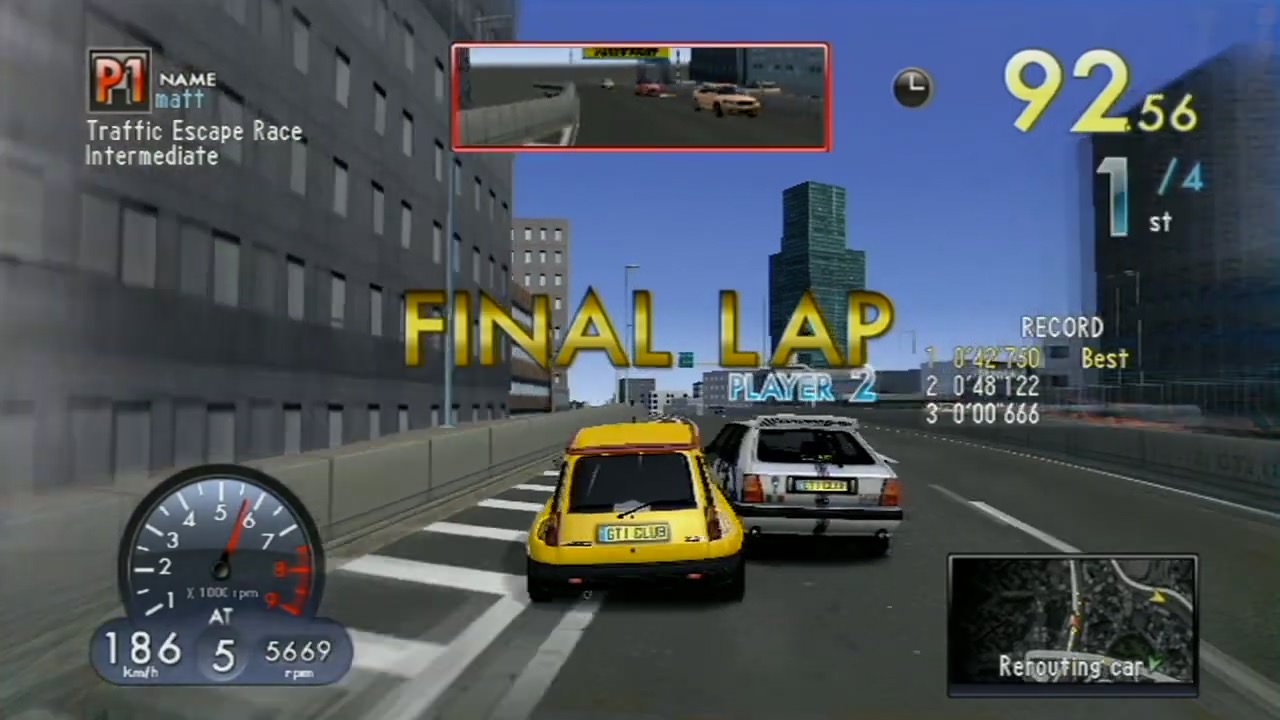
The ultimate hot hatch.
Most people are familiar with the first game in the GTi Club series due to its prevalence in arcades throughout the later half of the 1990s. The second game in the series is very hard to find in the wild, whilst the third is perhaps least known but a little easier to find and play today.
The PlayStation 3 received a loose port of the first arcade game, as GTi Club+, though it takes a lot of liberties. You may not notice if you’re going from 20-something year old memories of the original arcade game, but to me it feels more Western than Japanese and the classic GTi Club handling is largely missing. It’s very much a “blue sky” reinterpretation of the original arcade game running in the Sumo Digital racing game engine. It’s OK, but that’s all.
And that brings us to the home ports of GTi Club: Supermini Festa! The third game in Konami’s arcade series added extra locations, cars, and game modes to the original recipe whilst keeping the much loved controls including the handbrake. For this home port developer Genki built on the base of the arcade game and added even more, including online multi-player, game progression, and unlockable cars, modifications, liveries. And you can still play it online today with a modded Wii!
Released amongst the aftermath of the Icelandic ash cloud and greeted with physical delays before its arrival in retail stores, and perhaps even onto digital store fronts. The game finally released in Spring 2010, a mere two years after its release in arcades. The choice of Nintendo Wii and Sony PSP is a curious one, explained in part by the Wii being a huge seller but the PSP remains an odd choice. Maybe it was easy to target both these 480p platforms with one codebase or maybe it made more sense from a Japanese perspective? Regardless, due to the capabilities of the target home platforms the HD graphics of the arcade game are downscaled in resolution and complexity to 480p and, at least on Wii, the frame rate is kept high at 60fps.
Your first few games with GTi Club: Supermini Festa! might have you feeling a little nonplussed, and that was my experience when I received it in the post in March 2010. I played it for a bit and put it to one side. It was over a decade later that I returned to play it again—with a more open mind—and it really sunk its teeth into me.
The game starts off very easy, almost too easy, as you set about unlocking cars and game modes. You might think that there is no challenge, but before long you’ll notice that difficulty begins to ramp up and you have to be a little more selective with your car choice and how you choose to level-up your car stats. By about half way through the game, and perhaps earlier if you’re going for gold medals, you’ll need to figure out that to remaining competitive means figuring out the correct car to use for each challenge and failure to do so will result in you hitting an impasse. It’s a very Japanese level of difficulty, one could describe it as the Dark Souls of driving games. I’ve seen many people hit this wall and abandon the game just as it is about to show them what it really has up its sleeve. Nintendo do the same thing in many of their games, where you play through it once and only then are the most dedicated players greeted with the main event.
One final point is about control. In the early days of playing the game I was using motion control, which is well-implemented and very enjoyable. Later in the game, I found that I needed a control method with more reaction speed. I tried Wii SNES Controller, which helped but the digital nature of the controls felt very jarring on-screen. So I switched to analog stick control on a Wii Classic Controller Pro, which gives quicker turns and reactions in general. I later spoke with 赤しおん/Aka_sion—a Japanese player with whom I race online—who confirmed that all serious Japanese players who were playing online back in the day had made the same discovery.
At this point in time GTi Club: Supermini Festa! is one of a select few hard-to-find Wii games, so it commands a high price. If you’re not a collector it’s an easier choice, as you could essentially rent the game by buying it, playing it and selling it on. Or you might have other options depending on your propensity to sail the high seas. Come on in, the water’s lovely.
Enjoyed this blog post? Please buy me a coffee.
--
Comments: @gingerbeardman